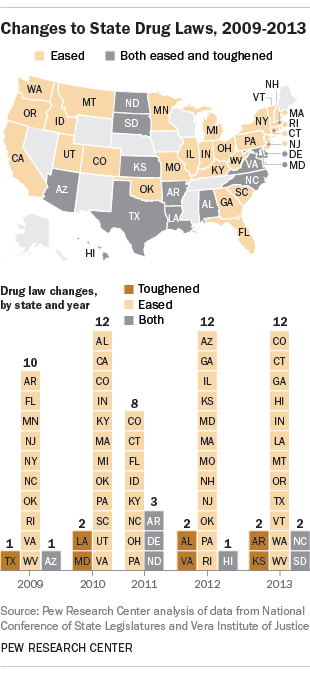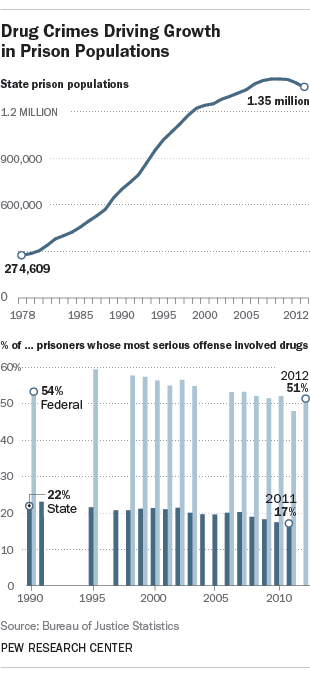
Federal drug policy is in the midst of a major conceptual shift away from the long, automatic prison sentences and zero-tolerance policies of the “War on Drugs” era. But it’s the states, whose prisons house the vast bulk of U.S. convicts, that have been leading the way in changing drug laws.
Much of the current rethinking of America’s drug war speaks to today’s environment: Violent crime has fallen, attitudes towards drugs have shifted and the Great Recession has squeezed public budgets.
There’s also wide public support for changing government drug policies. In a new Pew Research Center report, 67% of people said government should focus more on treating people who use illegal drugs, compared with 26% saying prosecution should be the focus. More than six-in-ten (63%) now say that state moves away from mandatory prison sentences for non-violent drug offenders is a good thing, versus 32% who called it a bad thing.
(It’s quite a different story than in 1990, when 73% of Americans favored a mandatory death penalty for “major drug traffickers,” and 57% said police should be allowed to search the houses of “known drug dealers” without a court order.)
Attorney General Eric Holder recently called for reduced sentences for low-level drug offenders in federal cases, with the aim of reducing the growth of the federal prisoner population. (About half of the nearly 200,000 federal inmates have been convicted of a drug offense.) Earlier, he said low-level drug offenders wouldn’t automatically be charged with offenses that carried strict mandatory minimum sentences, and gave Washington and Colorado the go-ahead to implement marijuana-legalization initiatives. This month, the U.S. Sentencing Commission is expected to vote on a set of amendments to the sentencing guidelines used by federal judges.
The interest in sentencing reform now spans Washington D.C.’s normal partisan and ideological battle lines. The Smarter Sentencing Act of 2014, now pending before the Senate, would cut mandatory minimums for a host of federal drug crimes. Its sponsors include Senate Majority Whip Richard Durbin, liberal Democrats Patrick Leahy and Sheldon Whitehouse, Maine independent Angus King, and libertarian Republicans Rand Paul and Mike Lee.
The federal moves come after years of similar changes at the state level. Between 2009 and 2013, 40 states took some action to ease their drug laws, according to a Pew Research Center analysis of legislative data provided by the National Conference of State Legislatures and the Vera Institute of Justice. Twenty-seven states moved only in the direction of easing, while 13 other states eased some laws and toughened others — often as part of a broader rethink of their drug policies.
State-level actions have included lowering penalties for possession and use of illegal drugs, shortening mandatory minimums or curbing their applicability, removing automatic sentence enhancements, and establishing or extending the jurisdiction of drug courts and other alternatives to the regular criminal justice system. Some have been minor tweaks, such as Idaho’s 2011 change that allowed people convicted of violent felonies to participate in drug courts under certain circumstances. Other states have taken very different approaches to drugs: New York, for instance, moved away from its harsh Rockefeller-era drug laws in 2009.
Last year, Vermont decriminalized possession of less than an ounce of marijuana, while Oregon (where possession of less than an ounce has been a noncriminal violation since 1973) made possession of more than an ounce a misdemeanor rather than a felony. All told, 16 states have passed laws decriminalizing marijuana; Maryland, which reduced penalties for marijuana possession and use in 2012, is now considering decriminalization legislation.
State-level policy changes may not get the attention of federal moves, but they can affect many more people. State prisons house more than six times as many prisoners as federal prisons — more than 1.35 million in 2012, according to the Bureau of Justice Statistics. And for 16.6% of all state prisoners, a drug crime is their most serious offense (down from 20% in 2006).
A key driver of state action has been rising prison populations and the expense of keeping people locked up. Nationally, per-inmate costs range from range from $14,603 in Kentucky to $60,076 in New York, according to a 2012 study of 40 states (based on fiscal 2010 data) by the Vera Institute. The total cost per inmate averaged $31,286 when pensions and retiree health care, capital expenditures, legal costs and other expenses are included.

Those costs add up. Texas, for example, spent $2.3 billion to add 108,000 prison beds between 1983 and 1997, said Richard Jerome of The Pew Charitable Trusts’ Public Safety Performance Project. But by 2007, the state was again out of prison space and the corrections department was asking for $900 million to build more prisons and operate the existing ones.
“Legislative leaders of both parties looked at this and decided it just didn’t make sense to put all of that money into prisons,” Jerome said. Instead, Texas expanded a range of treatment and diversion programs in 2007, including drug courts. Since then, Jerome said, the state has been able to close three prisons while the crime rate has continued to fall.
Arkansas, where the prison population doubled between 1990 and 2010 and corrections costs rose nearly eightfold, revised its drug laws in 2011 to reduce sentences for drug users and steer more of them into probation and other prison alternatives.
Such policy changes, along with falling crime rates, have helped lead to lower imprisonment rates in 31 states. From 2007 to 2012, the overall state imprisonment rate fell from 447 sentenced prisoners per 100,000 population to 413 per 100,000. Over the same period, the federal imprisonment rate edged higher, from 59 to 62 sentenced prisoners per 100,000.
